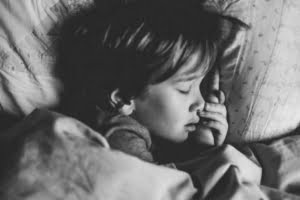Children are a precious gift, and parents will do just about anything to protect them and make them feel safe. Many parents have had to comfort and settle their children after they’ve had a nightmare.
There are times, however, that children shout or scream in distress while they’re sleeping; they look like they are awake but they don’t respond to their parent’s attempts to calm them down, and the following morning they don’t even recall the episode. If this has happened to your child, they have probably had what is called a “night terror.” San Diego Christian Counseling can help you address and manage these occurrences.
What are night terrors?
 Night (or sleep) terrors are episodes that are like nightmares, but they tend to be more dramatic and alarming, especially to parents who witness their child having them. Night terrors are episodes of intense crying, fear, screaming and thrashing during sleep.
Night (or sleep) terrors are episodes that are like nightmares, but they tend to be more dramatic and alarming, especially to parents who witness their child having them. Night terrors are episodes of intense crying, fear, screaming and thrashing during sleep.
Although they are a bit more common among boys, about 1- 6% of children have night terrors, and they happen to both boys and girls, and children of all races. These episodes, which can recur again and again, happen in children between 3 and 12 years of age, but they have been reported in babies as young as 18 months.
There are two main stages of the sleep cycle – rapid eye movement (REM) and non-rapid eye movement (non-REM). Night terrors occur during non-REM sleep, usually around 90 minutes or so after a child falls asleep.
When children have nightmares, they usually want to talk about it with their parents and be reassured that everything is going to be just fine. Unlike with nightmares, when they have night terrors, most children are not even aware of what is happening at the time, and they do not recall details of the night terror episode the following morning.
What are the symptoms of night terrors?
During a night terror episode, a child might:
- sit upright in bed
- thrash or flail about in their bed
- act scared
- breathe faster, and have a quickened heartbeat
 be upset
be upset- not talk
- have dilated pupils
- look awake but act confused and disoriented
- not respond to their parent’s comfort
- scream or shout in distress
- sweat
- seem like they don’t know their parent is there
It may take a few minutes to half an hour for the child to calm down after a night terror episode and return to sleep.
Diagnosing night terrors
Whether your concern is overnight terror episodes or nightmares, if frightening dreams or episodes are keeping you or your child awake at night for several nights (or weeks) in a row, consider talking with a health care professional. It is worthwhile discussing the situation with a medical expert to be sure you and your child get a good night’s sleep. Sleep disruptions, whether they remember them or not, can negatively affect your child’s daytime energy levels.
Your child’s doctor can usually diagnose night terrors based on a physical exam and their medical history. If they suspect that other health issues are at play, they might give additional tests to measure brain activity and check for a breathing disorder.
What are the causes of night terrors?
There are several potential causes of night terrors. Night terrors tend to run in families, with about 80% of kids having a family member who had them or other types of sleep disturbances like sleepwalking, but other factors may play a role in your child having night terrors.
As noted earlier, sleep happens in stages. The first stage of the sleep cycle, non-REM (rapid eye movement) sleep, is when night terrors occur. We have dreams, including nightmares, during the deeper rapid eye movement (REM) stage of the sleep cycle when our brains are most prone to vivid dreaming.
 Nightmares often happen later at night or in the early hours of the morning when the brain reaches the REM sleep part of the sleep cycle, while night terrors occur much earlier after going to bed.
Nightmares often happen later at night or in the early hours of the morning when the brain reaches the REM sleep part of the sleep cycle, while night terrors occur much earlier after going to bed.
A night terror is an abrupt reaction of fear that occurs when transitioning from one stage of the sleep cycle to another (from deep non-REM sleep into light REM sleep).
These transitions are usually without incident, but when the child is upset or frightened – in other words – when the central nervous system is over-aroused during sleep, this can lead to night terrors. The child experiencing a night terror may shout, scream or appear scared for a few minutes before they settle down and relax back into sleep.
Factors can include:
- stress
- too much caffeine
- medication that affects the central nervous system (brain)
- anxiety
- fever or illness
- depression
- being overtired and not getting enough sleep
- sleeping in a strange or new environment away from home
How to help your child
Although they are not harmful or dangerous, witnessing a night terror can be distressing for parents, especially when they don’t know what is happening and feel unable or unsure how to comfort their child. Night terrors disrupt sleep for you and your child, and in that way, they may negatively impact your child’s daily activities like school or their relationships with friends.
What can parents do to help their children when they have night terrors? While there is no treatment for night terrors, and night terrors tend to stop as your child gets older, there are a few things that parents can do to help prevent night terrors, and to help during an episode of night terrors.
In terms of prevention, the following may help:
 Try to create a simple and relaxing bedtime routine, and stick to it
Try to create a simple and relaxing bedtime routine, and stick to it- Don’t let your child get overtired or stay up too late
- Reduce the amount of caffeine your child ingests
- Reduce the stress or anxiety levels of your child
- Have the same wake-up time
- If your child has regular night terrors, breaking up their sleep may help (you can wake them up a few minutes before the expected night terror, and keep them out of bed and awake for a few minutes, continuing this routine for a week).
- Pray with your child before bedtime, asking God to help them sleep peacefully and without fear.
What can you do to help your child during an episode of night terrors?
Because it doesn’t work and may leave them even more confused and disoriented, it is not advisable to try and wake your child up during a night terror episode. It is better to patiently wait the episode out and try to make sure your child does not hurt themselves if they are flailing their arms and legs or trip over something in their room. Make your child’s room safe so that they (or anyone else) aren’t injured during an episode.
Conclusion
Night terrors and nightmares are both upsetting and scary occurrences that can cause sleep disturbances for parents and their children, but they are not the same thing. Getting to know some of the main differences between the two can help you ease your fears and anxiety by understanding what’s going on and discovering possible steps you can take to improve you and your child’s sleep.
There are several ways to mitigate the effects of night terrors, including pre-emptive steps like reducing stress, having a relaxing and consistent bedtime routine and making sure your child does not stay up too late. Parents can also make their child’s room safe so that they do not hurt themselves during an episode.
A child might have a single night terror or several before they stop. In many cases, night terrors will simply disappear on their own as your child’s nervous system matures. By their teen years, most children no longer have night terrors.
If night terrors happen repeatedly and they begin to negatively impact your child’s daytime activities, talk with a Counselor at San Diego Christian Counseling or other medical professional so that they can assist you and your child to have a good night’s rest for a healthy and productive life.
“Full Moon”, Courtesy of Noah Silliman, Unsplash.com, CC0 License; “You can’t see me”, Courtesy of Caleb Woods, Unsplash.com, CC0 License; “Fast Asleep”, Annie Spratt, Unsplash.com, CC0 License; “Night Sky”, Courtesy of Vincentiu Solomon, Unsplash.com, CC0 License


